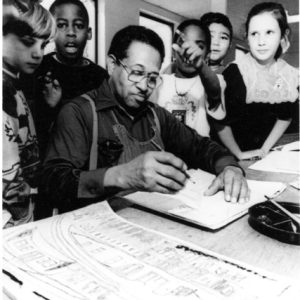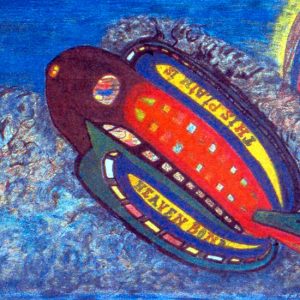calsfoundation@cals.org
Eddie Lee Kendrick (1928–1992)
Eddie Lee Kendrick was a self-taught artist who was inspired by the Arkansas landscape, his dreams, gospel music, and his Christian faith. Though Kendrick had drawn and painted all his life, his art was not well known until 1993, when three works were included in Passionate Visions of the American South: Self-Taught Artists from 1940 to the Present, an exhibition organized by the New Orleans Museum of Art and curated by Alice Rae Yelen.
Eddie Kendrick was born on September 20, 1928, on a farm near Stephens (Ouachita County), and he lived in Arkansas most of his life. He was the first of fifteen children born to farmers John Henry and Rutha Mae Kendrick. Kendrick helped in the annual slaughter of hogs, developing skills that equipped him for a career in meatpacking. He began his education at Springhill School, a one-room school for African-American children near Ogemaw (Ouachita County). He worked with his father cutting oak for a crosstie company and later for International Paper in Camden (Ouachita County).
In the mid-1940s, the family moved to Longley Settlement, a black community in southwest Pulaski County. Kendrick’s schooling ended after seventh grade at Longley School. He began a meatpacking career, most of which was spent at Brown Packing Company.
Religion and music were always at the center of the family’s life. Woods Temple Church of God in Christ in Higgins (Pulaski County), southeast of Little Rock (Pulaski County), became the family’s church. Here Kendrick served as a deacon and sang in the choir. He also sang with several gospel groups, including Hearts of Joy.
By the early 1950s, Kendrick was married to Dannie Marie Brown. The couple had no children and divorced in 1971. Kendrick had one biological child by another relationship. In 1981, he married Annie B. Cunning and became stepfather to three children. In 1989, that marriage also ended in divorce.
In the 1970s, Kendrick worked as a custodian at Parham Elementary School in Little Rock. There he was discovered by Ruth Kaplan Arnold, coordinator of the Little Rock School District’s Arts in Education program. Arnold arranged for Kendrick to paint during his free time and bought art supplies for his use. When Parham closed in 1979, Kendrick returned to Brown Packing Company, working until retirement in 1990.
In 1991, Kendrick agreed to be a visiting artist at Gibbs Magnet School of International Studies and Foreign Languages at the invitation of Susan Turner Purvis, art specialist, who bought his supplies. For several months, he painted in her space in the hall as the children looked over his shoulder.
Kendrick’s extant works date from 1977 to 1992, the last fifteen years of his life. During this period, his symbols for the way to eternal life evolved from the literal to the metaphoric. In earlier works, figures of Christ dominate the composition, as in The Second Coming of Christ! On the Clouds! The picture is divided horizontally between life on earth and eternal life. A large figure of Christ sits in the heavens amidst a wall of turbulent storm clouds and above a tidy landscape with elements of rural and urban Arkansas.
Symbols used in Church of God in Christ suggest the artist’s transition from the literal to the metaphoric. Another large figure of Christ has been placed to the left of the composition and points the way to heaven. Standing low in the clouds, his figure connects heavenly and earthly homes. To the right is a tower, its shape suggested by a dipping gourd perhaps. This metaphor provides visual and symbolic connections between heaven and earth. Kendrick added glitter to the tower, symbolizing the Holy Spirit, as he did in other works on fabric in the mid-1980s.
Around 1985, Kendrick began to use planes, trains, and boats for the way to heaven, eventually replacing the figure of Christ with visual metaphor and text as seen in This Plane Is Heaven Bound. Sometimes piloted by Christ, his bulbous planes were possibly inspired by the C-130s from Little Rock Air Force Base. These fat-bodied planes have made touch-and-go landings at Little Rock National Airport since the early 1970s. Kendrick lived south of the airport and would have often seen the low-flying aircraft.
On November 23, 1992, Kendrick died in Little Rock of cancer. He was buried in Springhill Cemetery in an unmarked grave. In 2000, a headstone bought by friends and family was placed on his grave. The epitaph is Psalm 121:1, one of Kendrick’s favorite scriptures: “I will lift up mine eyes unto the hills, from whence cometh my help.”
Kendrick’s art and life were celebrated with the retrospective A Spiritual Journey: The Art of Eddie Lee Kendrick. Curator Yelen organized the exhibition for the New Orleans Museum of Art. It opened in 1998 at the Arkansas Arts Center (now the Arkansas Museum of Fine Arts) to the strains of gospel music performed by Kendrick’s family. Six pieces of Kendrick’s work, including Church of God in Christ, are held in the Arkansas Museum of Fine Arts Foundation Collection.
For additional information:
Gunter, Beti. “Brothers Share Hobby: Their Art is for Others.” Arkansas Gazette. March 13, 1977, p. D2.
Obituary of Eddie Lee Kendrick. Arkansas Democrat-Gazette, November 24, 1992, p. B6.
Yelen, Alice Rae. Passionate Visions of the American South: Self-Taught Artists from 1940 to the Present. New Orleans: New Orleans Museum of Art, 1993.
———. A Spiritual Journey: The Art of Eddie Lee Kendrick. New Orleans: New Orleans Museum of Art, 1998.
Susan Turner Purvis
Little Rock, Arkansas
 Arts, Culture, and Entertainment
Arts, Culture, and Entertainment Divergent Prosperity and the Arc of Reform, 1968–2022
Divergent Prosperity and the Arc of Reform, 1968–2022 Eddie Lee Kendrick
Eddie Lee Kendrick  This Plane Is Heaven Bound by Eddie Lee Kendrick
This Plane Is Heaven Bound by Eddie Lee Kendrick 




Comments
No comments on this entry yet.